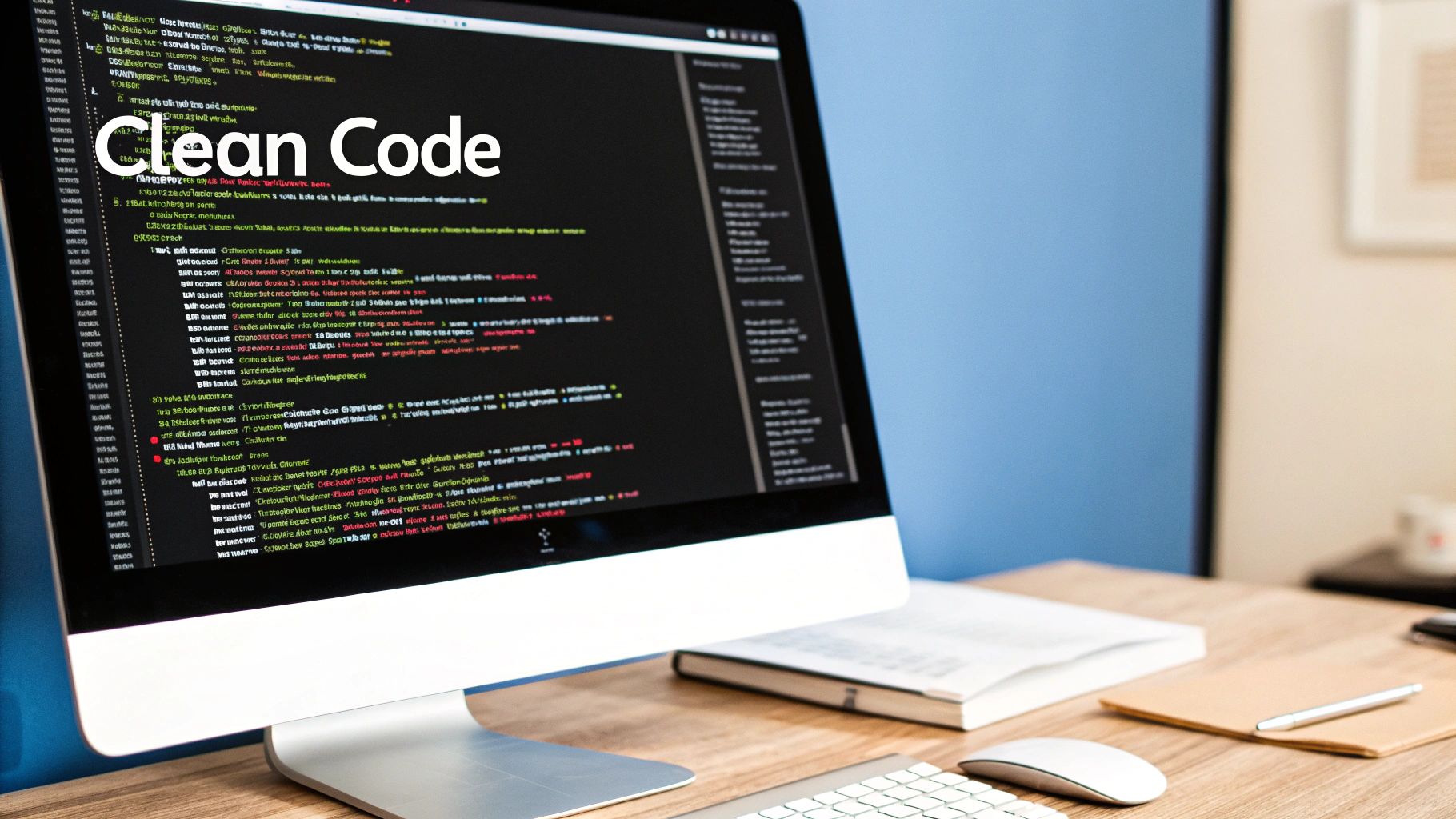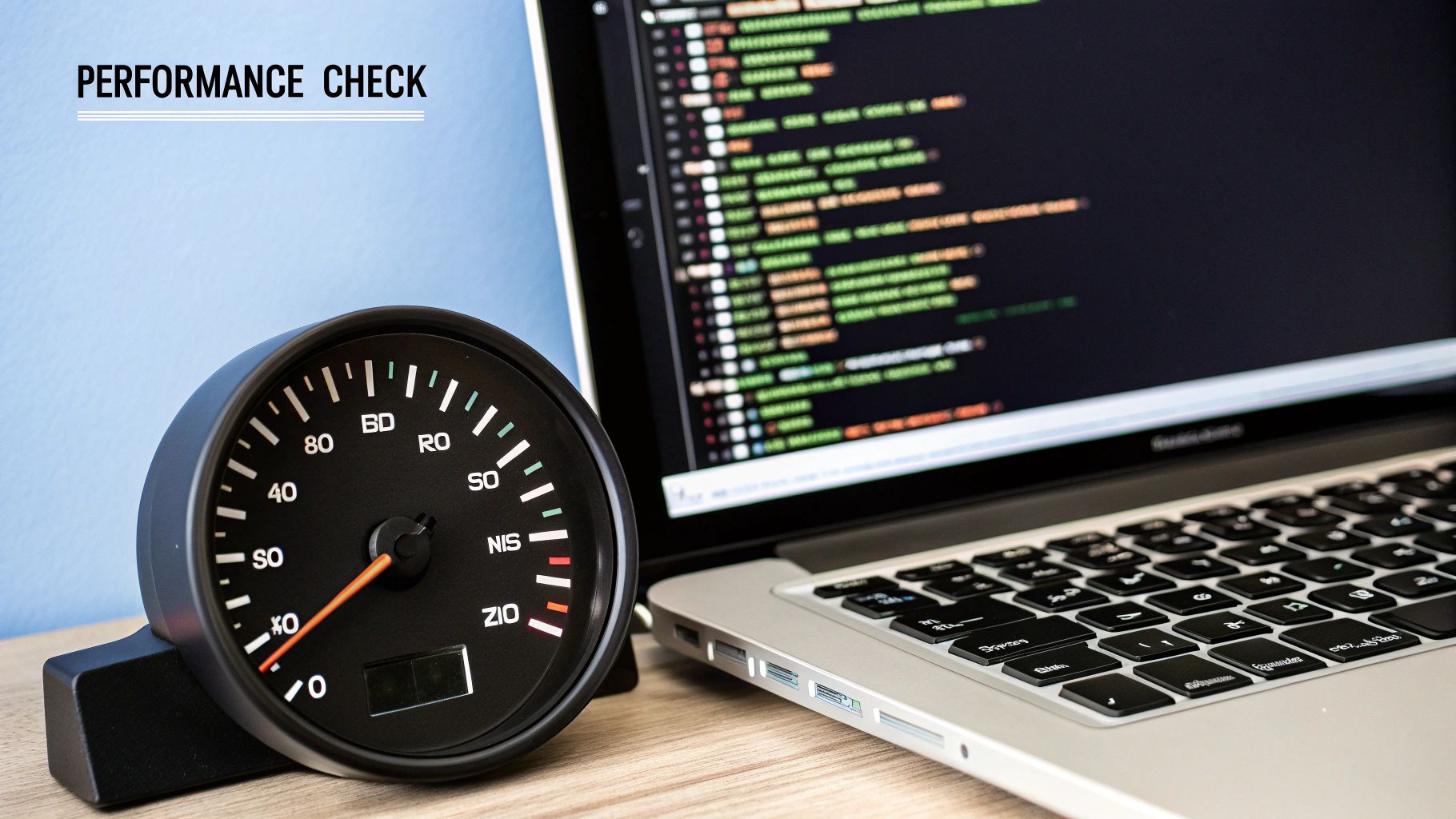- Published on
The Ultimate Code Review Checklist: 8 Checks for 2025
- Authors

- Name
- Gabriel
- @gabriel__xyz
In fast-paced development cycles, the pressure to merge pull requests quickly can lead to superficial reviews, often summarized by a quick 'Looks Good To Me.' But skipping a thorough review introduces technical debt, bugs, and security risks that can derail projects long-term. A well-defined code review checklist transforms this crucial process from a rubber-stamping exercise into a powerful tool for quality assurance, knowledge sharing, and team mentorship. It establishes consistency, catches subtle issues before they reach production, and builds a shared standard of excellence across the entire engineering team.
This guide provides an actionable and comprehensive checklist covering 8 critical areas, from functionality and logic to security and performance. Our goal is to help you and your team move beyond surface-level approvals and conduct reviews that genuinely elevate your codebase. By systematically implementing these checks, you'll not only ship more robust and secure software but also foster a culture of continuous improvement and engineering discipline. Let's dive into the specific checkpoints that will strengthen your review process.
1. Functionality and Logic Verification
The most fundamental purpose of a code review is to confirm that the new code works as intended. This step, a cornerstone of any effective code review checklist, involves meticulously checking that the implementation correctly fulfills the requirements outlined in the associated task, user story, or bug report. It's not just about seeing if the code runs; it's about ensuring the business logic is sound, algorithms are correct, and all potential user paths, including edge cases and error states, are handled gracefully.

Neglecting this check can lead to deploying features that are broken, incomplete, or introduce subtle bugs that corrupt data or disrupt user workflows. Giants like Google and Microsoft have built their engineering cultures around this principle. Google’s rigorous process reportedly catches the vast majority of bugs pre-production, while Microsoft's Azure team significantly cut critical bugs by systematizing logic reviews.
How to Verify Functionality
To effectively validate logic, reviewers must think like both a developer and an end-user.
- Test-Driven Development (TDD) as a Guide: Review the accompanying tests first. Well-written tests act as executable documentation, clearly stating the expected behavior for various inputs. If the tests are comprehensive, they provide a strong signal of the code's correctness.
- Manual Testing for Complex Flows: For intricate user interfaces or complex business logic, pull the branch and run the code locally. Click through the new feature, attempting to break it by entering invalid data or using it in unconventional ways.
- Focus on Edge Cases: Consider the "what ifs." What happens if a list is empty, a user is unauthenticated, a network request fails, or an input is null? The code should be resilient to these scenarios.
- Algorithm and Data Structure Check: Does the chosen algorithm solve the problem efficiently? Is the data structure appropriate for the task? Look for potential performance bottlenecks or off-by-one errors in loops and calculations.
Key Insight: The reviewer’s goal is to break the code. By adopting an adversarial mindset and actively trying to find flaws in the logic, you can uncover hidden issues before they impact users. This proactive approach is essential for building robust and reliable software.
2. Code Readability and Style Consistency
Beyond just making code work, a critical goal of any code review checklist is to ensure the code is understandable and maintainable for the future. This step focuses on enforcing established style guidelines, clear naming conventions, and consistent formatting across the codebase. It involves scrutinizing everything from variable names and indentation to commenting practices, ensuring the new code integrates seamlessly with the existing project, making it easier for any developer to pick up and contribute.

Ignoring readability creates a "write-only" codebase that is difficult to debug, refactor, or extend. Industry leaders like Google and Airbnb have famously published their comprehensive style guides, which have become industry standards. By enforcing consistency, they reduce cognitive load, minimize subjective debates during reviews, and accelerate onboarding for new engineers. This discipline prevents the accumulation of technical debt and common code smells that often appear in pull requests.
How to Enforce Readability
A clean, consistent codebase is a team effort, supported by both human oversight and powerful automation.
- Automate with Linters and Formatters: The first line of defense should be automated tools. Integrate linters like ESLint (for JavaScript) or formatters like Prettier and Black (for Python) into your CI/CD pipeline to catch stylistic inconsistencies before a human reviewer even sees the code.
- Check for Clarity and Naming: Are variable and function names descriptive and unambiguous? A function named
processData()is vague, whereascalculateUserTaxLiability()clearly communicates intent. Avoid abbreviations and magic numbers. - Review Code Structure and Organization: Functions should be small and adhere to the Single Responsibility Principle. Complex logic should be broken down into smaller, well-named helper functions. Ensure related code is grouped together logically within files and directories.
- Assess Comments and Documentation: Comments should explain the "why," not the "what." Good code is often self-documenting, but complex business logic or workarounds for external system quirks warrant clear, concise explanations.
Key Insight: Treat code as a form of communication. The primary audience for your code is not the compiler-it's the next developer who has to read, understand, and modify it. Optimizing for human readability pays long-term dividends in maintainability and team velocity.
3. Security Vulnerabilities Assessment
A secure application starts with secure code, making security analysis a non-negotiable part of any comprehensive code review checklist. This step moves beyond functionality to actively hunt for potential weaknesses that could be exploited by malicious actors. Reviewers must scrutinize the code for common vulnerabilities such as SQL injection, cross-site scripting (XSS), improper authentication, and sensitive data exposure, ensuring that secure coding practices are consistently applied.

Overlooking this crucial check can have catastrophic consequences, leading to data breaches, financial loss, and severe reputational damage. Proactive security reviews are a hallmark of mature engineering organizations. GitHub’s internal security reviews have famously prevented major token exposure incidents, while Shopify's security-first culture, embedded in its review process, is fundamental to protecting millions of merchants from constantly evolving threats.
How to Assess Security Vulnerabilities
To effectively identify security risks, reviewers should adopt an adversarial mindset, thinking like an attacker trying to breach the system.
- Consult Security Checklists: Leverage established frameworks like the OWASP Top 10 as a guide. Check for issues like insecure direct object references, cross-site request forgery (CSRF), and using components with known vulnerabilities.
- Validate Data Handling: Scrutinize all points of user input. Is data properly sanitized to prevent injection attacks? Is sensitive information like passwords or API keys encrypted both at rest and in transit? Never trust user-supplied data.
- Automate with Scanning Tools: Integrate automated security scanning (SAST) tools like SonarQube or Veracode directly into the CI/CD pipeline. These tools can automatically flag common security flaws, providing a first line of defense.
- Verify Authentication and Authorization: Confirm that authentication and authorization logic is correctly implemented. Can a user access data they shouldn't? Are session management and access controls robust and enforced on the server-side?
Key Insight: Security is not a feature to be added later; it is a fundamental requirement that must be built into the code from the start. A security-conscious review process treats every code change as a potential entry point for an attack, fostering a culture of collective responsibility for application safety.
4. Performance and Efficiency Analysis
Beyond just being correct, code must be efficient. This crucial step in any comprehensive code review checklist involves evaluating the new implementation for performance bottlenecks, resource consumption, and scalability. It's about ensuring the code doesn't just work now but will continue to perform well under the stress of real-world load conditions, a principle that is fundamental to the engineering cultures at companies like Amazon and Netflix.

Neglecting performance can lead to slow response times, high operational costs, and a poor user experience that drives customers away. For example, Netflix famously reduced streaming latency by 40% through rigorous performance-focused code reviews, and LinkedIn significantly improved page load times by scrutinizing database query efficiency. These gains highlight how proactive performance analysis directly impacts business success and user satisfaction.
How to Analyze Performance
Reviewers should adopt a forward-thinking perspective, considering not just current but future application load.
- Algorithm Complexity: Analyze the Big O notation of algorithms. A nested loop (O(n²)) that works for 10 items might bring a system to its knees with 10,000 items. Suggest more efficient algorithms where appropriate.
- Database Query Optimization: Examine database queries closely. Look for N+1 query problems, inefficient joins, or missing indexes. Ensure data retrieval is as lean as possible, fetching only what is necessary.
- Memory and Resource Usage: Assess how the code manages memory. Are large objects being held unnecessarily? Are there potential memory leaks? Efficient resource management is key to stable, scalable applications.
- Leverage Tooling: Encourage the use of profiling and load testing tools like JMeter or LoadRunner. Data from these tools can pinpoint exact bottlenecks, transforming performance tuning from guesswork into a science.
Key Insight: Premature optimization can be as harmful as no optimization. Focus on high-impact areas identified through profiling and monitoring tools. Address the 20% of the code that causes 80% of the performance problems, rather than making micro-optimizations that clutter the codebase for negligible gain.
5. Test Coverage and Quality Verification
Code without tests is a liability waiting to happen. This crucial step in any code review checklist goes beyond simply checking if tests exist; it involves verifying that the new code is supported by a comprehensive and high-quality test suite. The goal is to ensure that the changes are not only correct today but also protected against future regressions. It's about building confidence that the system remains stable as it evolves.
Failing to scrutinize test quality can lead to a false sense of security, where high coverage numbers mask ineffective tests. Industry leaders like Spotify and Shopify have institutionalized this principle. Spotify aims for over 80% test coverage across its critical microservices, while Shopify’s robust test suite reportedly catches 90% of potential regressions before they reach production, a testament to the power of quality verification.
How to Verify Test Quality
Effective test verification requires looking at what is being tested and, more importantly, how.
- Review Coverage Reports: Use tools like Codecov or SonarQube to check coverage metrics. Is the new logic covered? Are critical paths and error-handling branches included? Aim for a meaningful target, typically 80-90%, especially on core business logic.
- Assess Test Logic and Assertions: Read the tests themselves. Do they validate behavior or are they brittle tests tied to a specific implementation? A good test should fail if the feature breaks, not just if a method is renamed. Ensure assertions are specific and meaningful.
- Evaluate Test Types (The Pyramid): Check for a healthy mix of tests. The foundation should be a large number of fast unit tests, followed by fewer integration tests, and a minimal number of slow, end-to-end UI tests, following the test pyramid model popularized by Martin Fowler.
- Check for Reliability and Speed: Are the tests fast and deterministic? Flaky tests that fail intermittently erode team trust and slow down development cycles. Ensure mocks and stubs are used appropriately to isolate the code under test.
Key Insight: Treat test code with the same rigor as production code. Tests are not a one-time task; they are living documentation and a first-class citizen of the codebase. High-quality tests enable confident refactoring and accelerated feature delivery.
6. Code Architecture and Design Patterns
Beyond individual lines of code, a crucial part of any code review checklist is examining the bigger picture: the software's architecture. This step ensures the new code fits harmoniously within the existing system, follows established design patterns, and promotes long-term maintainability. It involves scrutinizing decisions related to modularity, separation of concerns, dependency management, and overall structural integrity.
Ignoring architecture leads to "code rot," creating a tightly coupled, brittle system that becomes exponentially harder to change. Companies like Uber evolved their microservices architecture through meticulous design reviews, while Netflix refines its robust event-driven systems by making architectural reviews a core practice. These efforts prevent technical debt from crippling future development and scalability. For deeper insights into structuring your changes, you can explore some pull request best practices.
How to Verify Architecture
Reviewers should assess how a change impacts the system's structural health and future flexibility, guided by principles from industry leaders like Martin Fowler and Robert C. Martin.
- Adherence to SOLID Principles: Check if the code follows established principles like Single Responsibility and Dependency Inversion. Is a class trying to do too much? Are high-level modules unnecessarily dependent on low-level details?
- Judicious Use of Design Patterns: Verify that design patterns (e.g., Factory, Singleton, Observer) are used appropriately to solve a relevant problem, not just for the sake of using a pattern. Over-engineering can be as harmful as under-engineering.
- Evaluate Modularity and Coupling: Does the new code create unnecessary dependencies between modules? Good architecture promotes high cohesion within modules and low coupling between them, making the system easier to understand, test, and maintain.
- Consider Future Extensibility: Ask how this change will affect future development. Does the design make it easy to add related functionality later, or does it paint the team into a corner? Always review with an eye on the project's roadmap.
Key Insight: A good architectural review thinks in years, not sprints. The goal is to ensure that today’s solution doesn’t become tomorrow’s major refactoring headache. Prioritizing a clean, scalable design is an investment in the team's future velocity.
7. Documentation and Comments Quality
Well-written code often tells you how something is done, but rarely why. This is where documentation and comments become indispensable. A crucial step in any code review checklist is to ensure the code is supplemented with clear, concise, and helpful documentation. This includes everything from inline comments explaining complex logic to updated README files and comprehensive API documentation that make the codebase accessible to both current and future developers.
Neglecting this aspect creates "tribal knowledge," where critical information is held by only a few individuals, increasing onboarding time and the risk of introducing bugs. Industry leaders like Stripe have set the standard with API documentation so clear it’s considered a product in itself. Similarly, the comprehensive documentation for frameworks like Django and React is a primary reason for their widespread adoption and vibrant communities.
How to Verify Documentation
To effectively review documentation, a developer must step into the shoes of someone completely new to this part of the code.
- Explain the 'Why', Not the 'What': Good comments clarify intent. Instead of
// increment i, a useful comment would be// increment i to skip the header row. Check that comments add context that the code itself cannot provide. - Keep Documentation Close to Code: Review that documentation for a specific function or module is located nearby, ideally as structured comments that can be parsed by tools like JSDoc or Sphinx. This proximity makes it more likely to be updated when the code changes.
- Check for Staleness: Is the documentation still accurate? The most dangerous documentation is that which is outdated and misleading. The review process is the perfect time to ensure that any changes in logic or function signatures are reflected in the corresponding comments and READMEs.
- Provide Constructive Feedback: When suggesting improvements, be specific and supportive. A well-framed comment can guide the author on how to clarify their documentation effectively. For more details on this, explore our ultimate guide to constructive feedback in code reviews.
Key Insight: Treat documentation as an integral part of the feature, not an afterthought. Code is written once but read many times. Investing a few extra minutes to document complex logic during the review saves hours of future developer time and prevents confusion.
8. Error Handling and Edge Cases
A critical aspect of any robust code review checklist is ensuring the code is resilient and behaves predictably under stress. This means scrutinizing how it handles errors, exceptions, and unexpected edge cases. It's not enough for code to work in a perfect "happy path" scenario; it must also fail gracefully, provide clear feedback, and maintain application stability when things go wrong.
Inadequate error handling leads to cryptic crashes, data corruption, and poor user experiences. Tech giants like Amazon and Netflix have built their empires on reliability, which is heavily dependent on sophisticated error management. Amazon's system can gracefully degrade parts of its site during peak traffic, preventing a total outage, while Netflix's "fail fast" and circuit breaker patterns ensure a single failing microservice doesn't bring down the entire streaming platform.
How to Verify Error Handling
To effectively review error handling, a reviewer must adopt a pessimistic mindset, actively looking for ways the code could break.
- Scrutinize
try-catchBlocks: Check iftry-catchblocks are used appropriately. Thecatchblock should not be empty or simply log a generic message. It should handle the exception in a meaningful way, perhaps by showing a user-friendly message or triggering a fallback mechanism. - Test for Null and Unexpected Inputs: What happens if a function receives a
nullvalue, an empty array, or an incorrectly formatted string? The code should anticipate these scenarios with proper validation and guards, preventing unhandled exceptions like aNullPointerException. - Evaluate External Service Failures: If the code interacts with an external API or database, simulate a failure. The application should handle timeouts, network errors, or invalid responses without crashing. This is where patterns like retries or circuit breakers are vital.
- Review Error Messages: Ensure error messages are specific, actionable, and helpful for both end-users and developers. A message like "An error occurred" is useless; "Failed to upload profile picture: file size exceeds 5MB limit" is much better.
Key Insight: Distinguish between programmer errors and user errors. Programmer errors (like a null reference) should fail fast and loudly during development to be fixed immediately. User errors (like invalid input) should be handled gracefully with clear, instructive feedback to guide the user toward a successful outcome.
8-Point Code Review Checklist Comparison
| Aspect | Functionality and Logic Verification | Code Readability and Style Consistency | Security Vulnerabilities Assessment | Performance and Efficiency Analysis | Test Coverage and Quality Verification | Code Architecture and Design Patterns | Documentation and Comments Quality | Error Handling and Edge Cases |
|---|---|---|---|---|---|---|---|---|
| Implementation Complexity 🔄 | Medium to High - Requires deep understanding | Low to Medium - Mostly formatting and style rules | High - Needs specialized security expertise | Medium to High - Requires performance expertise | Medium - Needs comprehensive tests | High - Requires architectural expertise | Low to Medium - Continuous upkeep and writing | Medium - Can add complexity to code |
| Resource Requirements ⚡ | Moderate - Time for thorough logic checks | Low - Automated tools available | High - Security tools and expert reviewers needed | Moderate - Profiling tools and testing environments | Moderate - Testing frameworks and coverage tools | Moderate - Design reviews and documentation | Low to Moderate - Documentation tools and effort | Moderate - Logging and monitoring tools required |
| Expected Outcomes 📊 | High ⭐ - Bug prevention, logic correctness | Moderate ⭐ - Maintainable, consistent codebase | Very High ⭐⭐ - Prevents vulnerabilities and breaches | High ⭐ - Optimized, scalable, efficient code | High ⭐ - Reliable, regression-resistant code | High ⭐ - Maintainable, scalable, testable architecture | Moderate ⭐ - Better onboarding and knowledge retention | High ⭐ - Stability and graceful failure handling |
| Ideal Use Cases 💡 | Critical business logic, complex algorithm code | Large teams, evolving codebases, onboarding | Any system handling sensitive data or exposed APIs | Performance-critical applications, high-load systems | Projects requiring high reliability and frequent changes | Long-term projects needing scalable architecture | Teams valuing knowledge sharing and maintainability | Systems exposed to errors, exceptions, and user inputs |
| Key Advantages ⭐ | Prevents costly bugs, meets requirements | Improves maintainability, speeds up onboarding | Protects data and reputation, ensures compliance | Enhances speed and resource efficiency | Reduces regressions, improves confidence | Supports SOLID principles, modular and clean design | Facilitates debugging, reduces knowledge gaps | Improves UX during failures, aids debugging |
Streamline Your Reviews and Ship with Confidence
Moving from theory to practice is where the real value of a robust code review checklist is unlocked. We've journeyed through the critical checkpoints that form the backbone of a high-quality, collaborative review process, from verifying core functionality and logic to scrutinizing architectural integrity and bolstering security. Each item on this list, whether it's enforcing readability standards, confirming test coverage, or stress-testing error handling, represents a crucial layer of defense against bugs, technical debt, and vulnerabilities.
Implementing this checklist isn't about adding bureaucratic hurdles; it's about building a shared language of quality and a systematic approach to excellence. It transforms code review from a subjective, ad-hoc task into a consistent, predictable, and educational engineering discipline. By internalizing these principles, your team doesn't just catch errors-you collectively raise the bar for what constitutes "done."
From Checklist to Culture
The ultimate goal is to embed these checks so deeply into your team’s workflow that they become second nature. This cultural shift has a powerful ripple effect, leading to:
- Accelerated Onboarding: New developers can quickly understand team standards and expectations by following the checklist.
- Reduced Friction: Clear, objective criteria minimize subjective disagreements and make feedback more constructive.
- Collective Ownership: Every team member becomes a guardian of the codebase's health and long-term viability.
- Sustained Velocity: Proactively addressing issues in review prevents them from becoming costly, time-consuming problems in production.
Adopting this comprehensive code review checklist is a strategic investment in your team’s efficiency and your product’s stability. It empowers developers to not only write better code but also to become better engineers. By committing to this structured process, you’re not just shipping features; you are building a resilient, maintainable, and high-performing software foundation, ready to scale and adapt to future challenges. The confidence gained from a thorough, well-executed review process is invaluable, allowing your team to deploy more frequently and with greater peace of mind.
Ready to supercharge your review process and eliminate the notification chaos that slows your team down? PullNotifier integrates directly with GitHub and Slack, delivering smart, real-time PR updates to the right people at the right time. Stop chasing reviews and start merging faster by trying PullNotifier today.